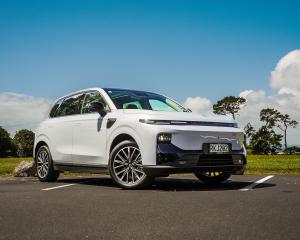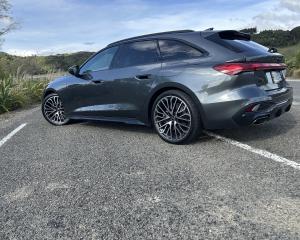
The MG Cyberster is in a class of one. No other mainstream brand with sports car pedigree has put an electric two-seater into full scale production. Yet.
MG might feel chuffed that next into the zone is a very famous brand; Porsche’s Boxster and Cayman go electric next year, albeit with petrol versions also on offer.
The Cyberster family, though, has no petrol bloodline, and more Cyber cars are planned to join the roadster already here in two forms, the as-tested $130,000 dual motor and a $20,000 cheaper single motor.
MG calls Cyberster the future of motoring. It’s a big call, even for a brand that has been famous for its sports cars. So what to make of it: brave or bonkers? In reality, it’s a bit of both.
While a big deal, this car is also a rare sight. Registration data at time of writing indicates only 10 have been plated in New Zealand since it availed 11 months ago.
How the Cyberster came about is one of those "right place, right time" stories. SAIC, the Chinese state-owned maker, still plays on the MG brands’ British heritage. The old MG image is tied to roadsters, so "new" MG needed one.

The pace of car development moves fast in China and a year in, one or two elements are already showing age. If they started again, it would have sharper, larger screens and smarter software. It must also be the last "new" MG demanding tethered rather than wireless CarPlay.
Regardless, the design is impossible not to notice.
It’s an assuredly good-looking car with classic roadster proportions, and less Gotham-esque in actual representation than it looks in imagery. The detailing is neat, with the obvious talking point being its power-operated super-style scissor doors.
If arresting looks are one key strength, the other is the performance. Even the rear-drive single-motor variant musters 250kW of power and 475Nm of torque. Stepping up to all-wheel drive, the dual motor packs a mighty 375kW/725Nm punch.
A 208kmh top speed is modest but alacrity from standstill more than makes up. To be sure, all electric cars have nifty step-off, but the Cyberster dual motor is among the year’s true electric shocks. In effecting 0-100kmh in 3.2 seconds, you don’t get the aural drama of a traditional combustion supercar, but it certainly has the ability to leave owners of many of those kinds of cars speechless.
Starting from a standstill in a standard driving mode, no foot on the brake, simply squishing the throttle is a mild approach, but is still pretty ferocious. Supersport/Track mode with launch control is the full-on lung-crushing, gut-punching, skull-snap brutal. Surely few will seek seconds.

Yet if you’re looking for an electric equivalent of an MX-5, best keep saving for that Porsche.
Two factors: the Cyberster is not small and nor, at 1985kg, is it light. Three times the kilogram count of the first Midget and K3 models MG kicked off with in 1924. Twice as heavy as the latest MX-5; the car that — ahem — nabbed the MG B’s title as the world’s best-selling two-seat sports car; also a product whose every gram was sweated over by Mazda. You get the sense MG wasn’t so zealous with the Cyberster.
Its battery pack may be thin — which saves the Cyberster from looking overly slab-sided — but it is heavy, and its bulk is betrayed by the Cyberster’s exaggerated width, wheelbase and the slightly high (for a sports car) cabin floor height. Mind you, the car as a whole has a heftiness to its look. And those doors? Try lifting one. On top of that, the electric mechanisms that do that job must surely add to the kilo count.
As a result, much as it has decent grip, good traction and sweet steering, country roads aren’t the best playground. With close to two tonnes to tame, anything fully twisty and sinuous gives the suspension and brakes a lot to deal with. The test car squirmed when pushed and, even when slipping back to a slow in, fast out cornering approach, with sprinting just on the bits between the bends, there’s still pitch under power and braking.
Everything works better when you dial back a notch. The three-level (coasting, strong and one-pedal) regenerative braking gets a chance to bring the speed down more gradually and though Comfort doesn’t alter the shock absorbers, they have a chance to cope with chop. Plus it improves efficiency, as the car regresses to the rear motor. It’s still feisty enough to deliver rear-wheel scrabble if you hoof too hard out of intersections, mind.
True roadster fans need little excuse to drop their tops, and doing so in the Cyberster is made easy with a power roof programmed to lower in just over 10 seconds at the push of a button, including on the move at less than 50kmh.

New Zealand (or at least the test car) seems to miss out on the factory wind diffuser that mounts between the rollover bars. Without it, the trick of having the side glass up reduces some wind swirl, but not a lot. And while there’s no engine noise, at speed there is enough wind and tyre roar to drown out the eight-speaker Bose stereo.
Every drive begins and ends with a show; the electric-driven door opening and closing is pure artistry, albeit not super-fast. Access and egress isn’t too awkward, and sensors prevent the doors opening if objects or people are too close.
The doors have two sets of buttons, those on the door tops for external opening, another on the base on the inner panel for closing (though still awkward for shorties to reach). Or you can use the remote; that’s more fun if someone’s showing interest and they don’t know who’s driving it. Come facelift time, MG might work out how to remotely operate the roof with the fob, too.
The cabin treatment is MG familiar, but embellished, notably with a higher screen count; four in all, three in front of the driver.
Even though it’s a pity some "metal" bits are wrought in plastic, stylistically it all looks very plush and glam; with decent equipment. Interestingly, in that respect, all that seems to separate the single and dual motor choices equipment-wise are the wheel sizes; 19s on the entry, 20s here.
Don’t misconstrue the elaborate steering wheel paddles. There’s no Hyundai N-style pseudo-manual gears involvement for a driver here. The left is for changing the regenerative braking rate, the right for flicking through drive modes.

Those who hold simple is best will see that ideal challenged by the utterly overwrought Drive/Reverse/Park selector system, and more. MG’s usual steering wheel controls are in place; those fragile-looking thumb scrollers hard to work through various menus and settings. And will discover quite soon it’s finickity operability. Some displays are hard to read at a glance; assuming you can get a clear view. I couldn’t, having found that the ideal driving position was one that sacrificed the view of all the displays to a varying degree.
When I say "ideal", it wasn’t really. The Cyberster’s seats are brilliant in shape and the trim, a combo of synthetic leather and a suede-effect material is smart; six-way electric adjustment for lumbar on both is great. But what you’d think would be a 101 of roadster design, a low seating position, isn’t provided. Common feedback from occupants of all sizes was that the seat base was 5cm higher than it needs to be. As a tall person, my eyeline was almost level with the top of the windscreen so as well as squinting to read the instruments, I was stooping too.
Roadsters aren’t expected to be primary choices for long drives, but if you had to, it wouldn’t be the worst, because there’s reasonable stowage — the boot is compact, but there is also good storage behind the seats.
Range-wise, having a 77kWh (73kWh usable) battery pack is a boon. The official range of 443km certainly won’t be achievable on an extended highway haul, but drive in a measured manner, and at least 380km seems possible. Fast DC charging at 144kW is reasonable, but AC charging limited to 7kW is a shame when others manage 11kW.
So it’s a sports car ... but aside from the berserk sprint ability, not a really sporty car. Porsche assures its incoming products are dedicated to enthusiast feel. So let’s hope MG snaffles up and breaks down a battery Boxster to see how Porsche achieves a result beyond the Cyberster in its current form.
As things stand, for all its foibles and flaws, the Cyberster demands recognition for being a bold step. Not truly great, but a great start.

MG confirmed at the 2025 Shanghai motor show that a production version is inbound. There’s conjecture it could be revealed in celebration of the 60th anniversary of the original MG B GT, in October.
AT A GLANCE
MG CYBERSTER
Overall rating: ★★★★
Design and styling: ★★★★
Interior: ★★★

Ride and handling: ★★★★
Safety: ★★★★
Environmental: ★★★★
SPECIFICATIONS
Price: $130,000.
Powertrain: Dual electric synchronous motor; maximum power 375kW, maximum torque 725Nm.

Safety rating: Not yet rated.
Wheels and tyres: Alloy wheels, 245/40 R20 front, 275/35 R20 rear.
Battery and economy: 77kWh lithium-ion battery pack, estimated combined economy (WLTP Combined test) 19.1 kWh/100km.
Dimensions: Length, 4535mm; width, 1913mm; height, 1329mm.
Weight: 1985kg.
By Richard Bosselman












